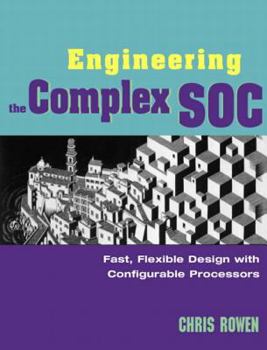Engineering the Complex Soc: Fast, Flexible Design with Configurable Processors
Engineering the Complex SOC The first unified hardware/software guide to processor-centric SOC design Processor-centric approaches enable SOC designers to complete far larger projects in far less... This description may be from another edition of this product.
Format:Paperback
Language:English
ISBN:0131455370
ISBN13:9780131455375
Release Date:June 2004
Publisher:Prentice Hall
Length:496 Pages
Weight:2.05 lbs.
Dimensions:0.9" x 7.3" x 9.5"
Customer Reviews
1 rating
Chip designers, managers, programmers, investors: READ THIS
Published by Thriftbooks.com User , 19 years ago
Chris Rowen, CEO of Tensilica, has an exceptionally broad history of successful experience in VLSI chip design, verification, software, systems design, multiprocessor applications, and EDA tools. This book draws on the integration of those experiences to build an exciting new approach to designing high-performance, low-cost, low-power chips and concurrently, well-tuned software. Investors and managers should read Chapters 1,2,3 which analyze the trends and issues in System-on-Chip design, and motivate the use of a new approach that combines extensible processors with powerful software to create software and hardware in parallel, faster, and with less engineering effort. They should also read Chapter 8, which makes insightful prognostications about a future in which many chips will have hundreds of CPUs, or more.If those Chapters describe What's Happening, and Why We Must Change, Chapters 4-7 explore How to Do It, and should be read by both hardware and software engineers who build embedded systems. The real-world examples (from Tensilica) and advice offer strong support that this approach actually works.Although it certainly promotes the Tensilica viewpoint, it is well-motivated, well-referenced to the last 20 years of computing research, and has good comparisons with other approaches, i.e., it is not just a commerical sales-pitch. The book is clearly written (modulo a few typos), and can be used by readers of varying depth of experience and knowledge. Computers have improved drastically in the last two decades, but we humans have not improved in speed or memory, and we are limited in the number of things we can really grasp at once. Real computing breakthroughs happen when people invent cost-effective ways to raise the level of abstraction, so that our brains can ignore low-level details and focus on larger issues. Increasing CPU performance enabled people to shift some work from assembly code, to higher-level languages like FORTRAN or C, to early scripting languages [like UNIX's shell and awk], and then to even higher-level languages like TCL, Perl, PHP, Python, etc. These have enabled large numbers of people to build their own Web-based applications. It is simply unimaginable that we'd have all those applications if people had nothing but assembler and C.I think this book describes a similar kind of breakthrough, which drastically raises the level of abstraction in concurrent hardware/software design, to take advantage of the huge nubmers of transistors now available at low cost. This doesn't mean that other design approaches will disappear (just as C hasn't gone away), but I do believe the approach described here will find increasingly wide usage, and it will certainly change the landscape. Chris is an old colleage from MIPS and SGI, and I always appreciated his insights, and this book integrates them into a very useful whole.




